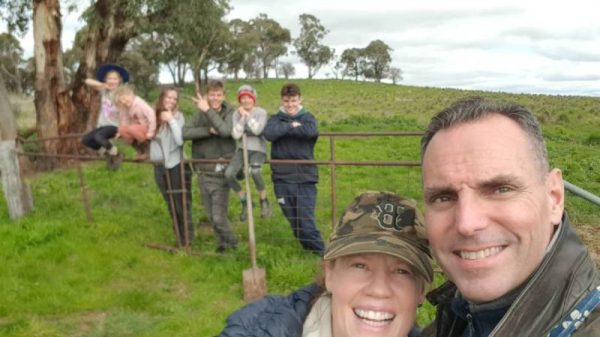In the Bardiya region of Nepal, near the western border with India, Bhadai Tharu grew up with tales of tigers.
They were not common in the forests around his home. At the turn of the 20th century, more than 100,000 tigers roamed Asia. But by the time Tharu was growing up in the 1970s, the tiger population had dwindled to just 20% of its peak.
It didn’t stop his parents from narrating stories about them when he was a child. Living in the forested region where tigers were king of the jungle, the big cats took on a kind of mythical quality, Tharu says: on the rare occasion one ventured into the village, it was taken as a sign of the gods’ displeasure. The villagers would set up a “Madhwa, a place of worship for tigers as deities,” a ritual that continues to this day, he says. As an adult, he became involved in forest conservation and was committed to protecting their habitat.
So when a tiger attacked Tharu in 2004, causing him to lose an eye, he felt as if he was being punished.
“I was furious with the tiger,” he says. “Inside, I was seething with anger, and I even felt the urge to return to the jungle and seek vengeance against the tiger.”
But as time passed, Tharu says his anger faded. “I came to realize that the jungle is the tiger’s home, and it only attacked me out of fear that I might harm its habitat.”
He recalls that on the day of his attack, there were around 100 to 150 community members in the forest collecting wood and grass, which he was overseeing as chairman of the community forests initiative.
“People were dispersed throughout the forest, and the tiger found itself surrounded by humans, unable to find an escape route,” he says. “The tiger that attacked me felt scared. It could have killed me, but it just attacked and left.”
Tharu recommitted himself to protecting Nepal’s tiger population — as well as preventing human-wildlife conflict in the region.
King of the jungle
Back in the 1980s, the land around Tharu’s village, Khata, was barren and deforested. But in 2001, the land was handed over to local communities, who rely on the forest for materials and sustenance, says Tharu.
This area, known as the Khata corridor, links the Katarniaghat Wildlife Sanctuary in Uttar Pradesh, India, and Nepal’s Bardiya National Park. The forest grew from 115 hectares to 3,800 hectares, and in 2021 won the WWF’s Conservation Excellence Award. And as the forest was restored, the wildlife returned too, says Tharu — including tigers.
Bardiya National Park and the Khata corridor are part of the Terai Arc Landscape, a 24,710 square kilometer area along the Nepal-India border that covers six protected areas including forests and wetlands. In 2010, Nepal set a goal to double the number of tigers from 121 to 250 — but it exceeded that target, tripling the population to 355, according to WWF.
The Khata corridor has “significantly contributed to tiger conservation” in the region, in particular the crackdown on poaching, which has been “completely eradicated,” says Umesh Paudel, a researcher based at the Bardiya base of the Nepalese non-profit National Trust for Nature Conservation (NTNC), one of several NGOs that support the community forests initiative.
“Typically, wildlife does not consider such corridors their permanent habitat,” says Paudel. Prior to the conservation efforts, tigers were rarely spotted by cameras in the corridor — but Paudel says that in the 2021 tiger census, it was found that four tigers were permanently living in the Khata corridor.
Territorial in nature, tigers need up to 58 square miles to roam and constantly seek new habitats — and the corridor has allowed the population to move freely and flourish, says Paudel.
Tracking tigers
While the growing tiger population is a great conservation success story, the region is now facing a new problem: escalating human-wildlife conflict.
Tiger attacks like Tharu’s were a rare occurrence in 2004. But as the tiger population increases, these attacks are becoming more frequent, and since 2019, there have been at least 34 fatal attacks on people in the Banke and Bardiya National Parks alone, says Paudel. Around 6,000 communities live in the corridor, and a busy highway runs through the middle, creating more opportunities for conflict.
The NTNC monitors the tigers with camera traps and identifies potentially problematic tigers. After an attack, a tiger will often revisit the site, says Paudel, allowing the team to profile the animal and analyze behavior patterns.
“If we ascertain that these tigers are frequently involved in human casualties, we recommend their capture,” he says, adding this is carried out by a team comprising the Nepalese Army, the National Park office, and NTNC.
In addition to tracking and monitoring the tigers, the NTNC also manages the local deer population — the tiger’s main prey — to ensure there is enough food, and that the correct areas of the park, away from villages, are most attractive for the deer to live in. “This practice helps in containing tigers within the national park, thereby minimizing conflicts within the community,” says Paudel.
Similarly, the creation of artificial watering holes has also helped to disperse the tiger population and direct animals away from local communities.
However, tiger population growth isn’t the only reason behind the increased human-wildlife conflict, says Paudel. “Our community members are encroaching upon wildlife habitats, venturing into the forests alone, and disturbing the natural habitat. As a result of this disturbance, they often encounter attacks from tigers.”
It is easier to influence human behavior than change the tigers, says Paudel, and so NTNC also works on community outreach to educate and empower, and prevent attacks by installing infrastructure such as fences and shelters.
“It is crucial to prioritize community development, to ensure that communities become advocates for tiger conservation,” Paudel adds.
Even as human-animal conflicts increase, Tharu says the local communities are happy to see the tiger population flourish. As apex predators, tigers are a keystone species which means that they are essential to the forest ecosystem that the surrounding communities rely on for their homes, sustenance and livelihoods. “The tigers were once endangered, and now they are back. It is good news for us,” Tharu says.
By teaching communities to take precautions, he hopes that attacks can be reduced too. “Every being has equal rights on the earth,” he says.







































